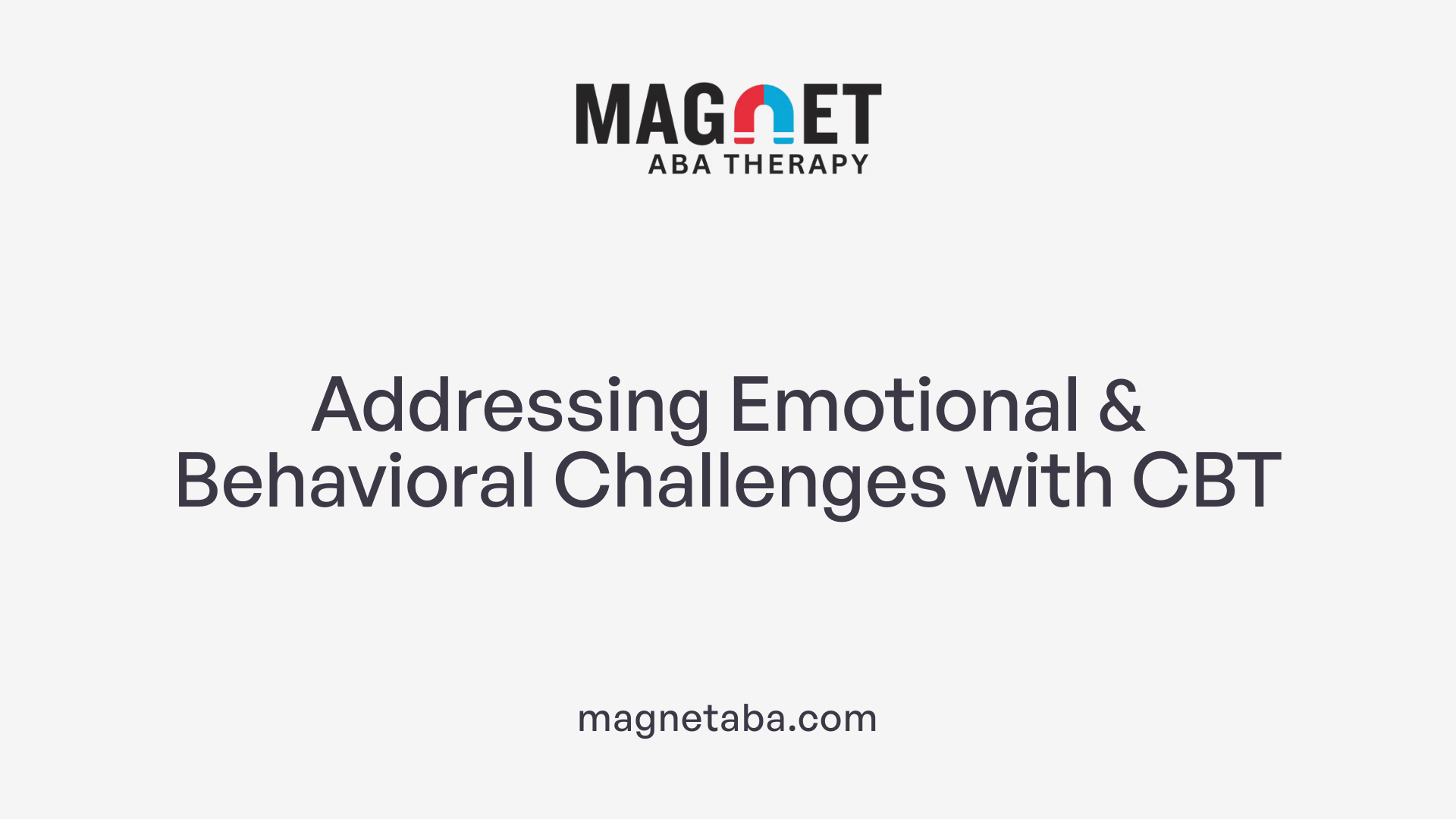Understanding the Foundations of Teaching Peer Interaction
Teaching appropriate peer interaction to children with autism is a pivotal aspect of supporting their social development and overall well-being. Utilizing evidence-based practices (EBPs) ensures that interventions are effective, measurable, and tailored to each child’s unique needs. This article explores key methodologies, behavioral principles, and practical steps for fostering successful peer interactions among children with autism spectrum disorder (ASD).
The Importance of Evidence-Based Practices in Autism Intervention

What Are Evidence-Based Practices and Their Role in Autism?
Evidence-Based Practices (EBPs) are interventions that have been scientifically proven to be effective through rigorous research. In autism therapy, EBPs play a crucial role by guiding educators and therapists to select strategies that specifically address the unique behavioral and educational needs of children with Autism Spectrum Disorder (ASD).
Why Are Evidence-Based Practices Important in Autism Therapy?
Implementing EBPs improves outcomes for children with autism by teaching appropriate behaviors and skills and reducing inappropriate behaviors. This approach ensures interventions are not only effective but are supported by scientific evidence, leading to more consistent and meaningful progress.
How Do EBPs Benefit Social Skill Development?
EBPs such as peer-mediated strategies and social skills training enhance social interactions for children with ASD. By utilizing methods aligned with natural interests and environmental manipulations, EBPs encourage social engagement and communication, which are often challenging areas for these children.
Impact on Reducing Inappropriate Behaviors
EBPs also focus on reducing behaviors that may interfere with learning or socialization. Techniques grounded in Applied Behavior Analysis (ABA) help replace challenging behaviors with functional alternatives, improving the child's ability to participate successfully in educational and social settings.
In summary, EBPs provide a scientifically backed framework that improves social skills and reduces problematic behaviors, making them an essential component in autism intervention programs.
Applied Behavior Analysis (ABA): The Cornerstone of Behavioral Intervention

What is Applied Behavior Analysis (ABA) therapy and how is it used to support individuals with autism?
Applied Behavior Analysis (ABA) therapy is an evidence-based approach that uses learning principles to improve behaviors and skills in individuals with autism spectrum disorder (ASD). By applying techniques such as positive reinforcement, prompting, and systematic data collection, ABA helps teach essential skills like communication, social interaction, and daily living activities, while also reducing inappropriate behaviors.
ABA programs are highly individualized, tailored to each person's unique needs, and can integrate naturalistic, play-based methods to encourage skill use across multiple environments. Early Intensive Behavioral Intervention (EIBI), a form of ABA delivered intensively over time, has demonstrated significant improvements in IQ and adaptive behaviors, often observable after 12 months of intervention.
How ABA supports individuals with autism
ABA addresses a wide range of behavioral and educational needs by breaking down complex skills into manageable steps. It focuses not only on teaching new skills but also on improving social functioning and reducing challenging behaviors through consistent reinforcement and prompting strategies.
Techniques such as shaping, graduated guidance, and environmental manipulation are commonly used within ABA to support areas such as toilet training and social engagement. Additionally, ABA promotes generalization—helping individuals apply learned skills across varied settings, including home and community environments.
Core principles and techniques in ABA
Key components of ABA include:
- Discrete Trial Training (DTT): Teaching skills in structured, repetitive trials.
- Naturalistic Developmental Behavioral Interventions (NDBI): Integrating ABA with developmental approaches during natural play or daily routines.
- Positive Reinforcement: Encouraging desired behaviors by rewarding them.
- Data Collection and Analysis: Continuously monitoring progress to ensure effective implementation and inform adjustments.
- Fidelity Monitoring: Using checklists to maintain consistency and quality in intervention delivery.
Benefits of ABA therapy
Numerous studies support ABA's effectiveness in improving verbal communication, social skills, adaptive behaviors, and reducing challenging behaviors. ABA promotes supportive learning environments and fosters independence, enabling individuals with autism to participate more fully in their communities. Its versatility allows collaboration with families and educators, ensuring interventions align with personal goals and available resources. Moreover, ABA's evidence-based nature helps distinguish it from less effective or unsupported therapies, emphasizing meaningful outcomes for those with ASD.
Who Provides ABA Therapy? Roles of Professionals and Families
Types of professionals involved in ABA
ABA therapy is typically delivered by a team of trained professionals with expertise in behavioral analysis. Board Certified Behavior Analysts (BCBAs) play a central role by designing and supervising individualized treatment plans tailored to the needs of each child with autism. Registered Behavior Technicians (RBTs) and other behavioral specialists carry out direct intervention sessions with children, applying evidence-based practices under the BCBA’s guidance.
Qualifications and certifications
Professionals providing ABA hold specific credentials ensuring their competency. BCBAs undergo rigorous training, experience requirements, and pass certification exams. RBTs complete specialized training and competency assessments before working directly with clients. This structured certification framework guarantees that ABA therapy is delivered with fidelity and effectiveness.
Role of family and caregivers
Family members and caregivers are vital participants in ABA therapy. They often receive training to support and reinforce skills learned during sessions at home and in natural settings. Engaging caregivers enhances generalization and maintenance of behaviors, ensuring a consistent, supportive learning environment across settings and situations.
Collaboration for optimal outcomes
Successful ABA therapy hinges on close collaboration among professionals, families, and caregivers. Regular communication ensures treatment goals align with the child’s needs and progress is monitored through ongoing data collection. This cooperative approach fosters adjustments to interventions as necessary, promoting better outcomes and smoother generalization of skills to everyday life.
Key ABA Techniques to Promote Peer Interaction
What are the key components or techniques used in ABA therapy?
Applied Behavior Analysis (ABA) uses a variety of structured techniques to teach appropriate behaviors, including those that improve peer interaction among children with autism. Some of the primary methods include:
Discrete Trial Training (DTT): This technique breaks down skills into small, manageable steps, teaching them one at a time with clear beginning and end points. Each trial involves an instruction, a response from the child, and a consequence, such as positive reinforcement.
Positive Reinforcement and Prompting: Positive reinforcement strengthens desired behaviors by offering rewards immediately after the behavior occurs, encouraging repetition. Prompting involves providing cues or assistance to help the child perform the desired skill, gradually fading prompts as independence grows.
Behavior Chaining and Task Analysis: Complex skills are taught by breaking them into a sequence of smaller steps (task analysis). Behavior chaining links these steps together so that each one triggers the next, allowing children to learn multi-step social interactions or routines.
Modeling and Script Fading: Modeling allows children to imitate appropriate social behaviors demonstrated by others. Script fading involves teaching social scripts (pre-planned phrases or dialogues) that are gradually faded to encourage spontaneous communication during peer interactions.
Use of Data and the ABC Framework: ABA relies heavily on continual data collection to monitor progress. The Antecedent-Behavior-Consequence (ABC) framework helps identify triggers and outcomes of behaviors, allowing for precise interventions tailored to the child’s needs.
How do these techniques support peer interaction?
By using discrete trials, children can learn social skills such as greetings, sharing, or turn-taking in a controlled and repetitive way. Reinforcement encourages positive social behavior by rewarding peer engagement. Task analysis and chaining assist children in mastering multi-step social routines like playing games or participating in group activities.
Modeling offers examples of appropriate social interactions, and script fading helps children move from scripted to natural conversations. Continuous data collection and the ABC approach ensure interventions remain effective and allow adjustments based on individual responses.
Why are these techniques effective?
These strategies promote skill acquisition across different settings, support generalization to natural environments, and enhance motivation through personalized reinforcers. The structured yet flexible ABA approach facilitates meaningful peer connections and reduces challenging behaviors, fostering independence and social competence in children with autism.
Setting Clear Goals and Collecting Baseline Data for Effective Intervention
Defining target behaviors
Selecting effective interventions begins with clearly identifying the target behavior. This behavior should be discrete, meaning it is distinct and separate from other actions; observable to allow others to notice it; measurable so progress can be tracked; and clearly defined to avoid ambiguity.
Importance of observable, measurable criteria
Using observable and measurable criteria ensures that behaviors are tracked consistently and reliably. This clarity allows educators and therapists to understand exactly what is being addressed and reduces misunderstandings in implementation.
Collecting baseline data over days
Before implementing any evidence-based practice, it is essential to collect baseline data across at least four days. This data provides an accurate picture of the student's initial behavior level, helping to inform intervention planning and measure progress effectively.
Aligning goals with Individualized Education Plans (IEPs)
Goals set for the intervention should be specific, measurable, and directly connected to the student’s IEP or Individualized Family Service Plan (IFSP). They should clearly state where and when the behavior is expected to occur, ensuring that interventions are individualized, relevant, and outcome-focused.
Incorporating Student and Family Characteristics When Selecting Interventions
Considering child’s preferences and needs
Selecting an effective evidence-based practice (EBP) begins with a clear understanding of the child's individual preferences and needs. Incorporating a child's favorite interests can rapidly increase social engagement and verbal initiations. For example, using preference assessments like the multiple stimulus without replacement (MSWO) method can identify what motivates the student, enhancing intervention effectiveness. Environmental manipulations that allow children to choose stimuli aligned with these preferences also boost motivation for social interaction.
Family involvement and resources
Family characteristics and resources play a crucial role in intervention planning. Parent-Mediated Interventions (PMI) demonstrate the importance of involving families to improve communication, language, and adaptive behaviors. Considering family availability, access to services, and familiarity with the intervention approach ensures that chosen practices are feasible and sustainable. Tailoring interventions to fit within family routines enhances generalization and long-term success.
Staff expertise and setting factors
The expertise of staff members and the intervention setting influence the selection and implementation of EBPs. Educators and therapists with specific training in interventions such as Applied Behavior Analysis (ABA), Early Intensive Behavioral Intervention (EIBI), or Naturalistic Developmental Behavioral Interventions (NDBI) can deliver more effective support. Additionally, consistent implementation across multiple settings—home, school, or community—facilitates skill generalization and maintenance.
Personalizing intervention choice
Combining these factors—child preferences, family context, staff skills, and available resources—enables personalized intervention selection. This thoughtful approach fosters more meaningful outcomes by ensuring the intervention matches the student's learning style and life environment. Tailoring EBPs in this manner fosters supportive learning environments that reduce challenging behaviors and improve overall development.
Ensuring Fidelity and Consistency in Implementing EBPs
How are fidelity checklists used in implementing EBPs?
Fidelity checklists are valuable tools designed to monitor the implementation of evidence-based practices with accuracy and consistency. These checklists help educators and therapists ensure that each step of an intervention protocol is followed as intended. The use of fidelity checklists guarantees that the intervention remains true to its evidence-based design, thereby maximizing its effectiveness for children with autism.
Why is continuous data collection important during EBPs?
Continuous data collection plays a crucial role in evaluating both the effectiveness of the intervention and its fidelity. Collecting ongoing data allows practitioners to track progress toward set goals and detect any variations in the delivery of the intervention. This data-driven approach supports timely decision-making and ensures the intervention is meeting the behavioral and learning needs of the child.
What is the significance of consistency across settings and staff?
Consistency in implementing EBPs across different environments and among various staff members significantly enhances the efficacy of interventions. When the strategies are executed uniformly in school, home, or community settings, children experience a coherent and predictable learning process. This uniformity supports skill generalization, helping children apply learned behaviors in natural contexts and promoting sustained progress.
How do ongoing data and feedback influence instructional adjustments?
Ongoing data collection enables practitioners to make informed adjustments to instructional practices as needed. If data indicate that progress is slower than expected or if fidelity falters, practitioners can modify strategies or provide staff with additional training. This continual refinement based on real-time information ensures that instructional practices remain responsive to the child's evolving needs, resulting in better outcomes.
Maintaining high fidelity through checklists, collecting continuous data, ensuring consistent application across people and places, and making timely instructional adjustments are all essential steps to optimize the benefits of EBPs. Together, these practices create a dynamic, effective learning environment that supports children with autism in achieving meaningful behavioral and developmental goals.
Leveraging High-Leverage Practices Alongside EBPs
What is Functional Behavior Assessment (FBA)?
Functional Behavior Assessment (FBA) is a systematic process used to identify the reasons behind challenging behaviors in children with autism. It helps educators and therapists understand the purpose a behavior serves for the child, which informs the development of effective interventions. FBA is considered a high-leverage practice because it directly guides evidence-based approaches tailored to reduce inappropriate behaviors and teach more appropriate skills.
How Do Peer-Mediated Strategies Support EBPs?
Peer-mediated strategies engage typically developing peers in supporting social interactions and learning for children with autism. These strategies capitalize on natural social opportunities to encourage communication, play, and social skills development. By involving peers, these approaches complement EBPs by creating authentic, supportive learning experiences that foster generalization of skills across settings.
Why Are Supportive Learning Environments Important?
Supportive learning environments are those that are nurturing, predictable, and responsive to the unique needs of children with autism. By combining EBPs with high-leverage practices like FBA and peer-mediated strategies, educators can design environments that promote positive behaviors and reduce triggers for challenging behaviors. Such environments ensure that interventions are consistently implemented and meaningful for the child.
How Do These Practices Help Reduce Challenging Behaviors?
The integration of high-leverage practices with EBPs creates a comprehensive approach to behavior management. FBA pinpoints the causes of challenging behaviors, allowing for targeted interventions. Peer-mediated methods provide socially motivating contexts that encourage positive interactions. Consistency across settings, staff, and materials maximizes the effectiveness of interventions, ultimately leading to a reduction in challenging behaviors and improved outcomes for children with autism.
Naturalistic Developmental Behavioral Interventions (NDBI) and Social Communication
What Are Naturalistic Developmental Behavioral Interventions (NDBI) and the Early Start Denver Model (ESDM)?
Naturalistic Developmental Behavioral Interventions (NDBI) are approaches that combine principles from behavioral science with developmental strategies, providing learning opportunities in natural settings. One well-known NDBI is the Early Start Denver Model (ESDM), tailored for very young children with autism spectrum disorder (ASD).
How Do NDBIs Improve Language and Imitation Skills?
Research shows that NDBIs like ESDM contribute to moderate improvements in children's language abilities and imitation skills. These improvements occur as children engage in play and daily routines that reflect their interests and developmental levels, making learning more meaningful and effective.
How Do NDBIs Foster Social Communication?
NDBIs emphasize social interaction by leveraging a child's natural motivations and preferences. By embedding teaching moments within enjoyable activities, these interventions encourage children to communicate more frequently and naturally. This focus on social communication helps children with ASD develop essential skills in engaging with others in everyday environments.
Social Skills Training (SST) and Its Impact Across Ages
How Effective Is Social Skills Training for Individuals with Autism?
Social Skills Training (SST) is a targeted intervention used to improve social functioning in individuals with autism spectrum disorder (ASD). It focuses on enhancing interpersonal skills such as communication, cooperation, and understanding social cues. Extensive research including meta-analyses shows that SST produces medium to large effect sizes, signaling significant improvements in social abilities across participants.
What Does Research Say About the Impact of SST?
Studies show that SST can lead to meaningful gains in social interaction, peer relationships, and social problem-solving. These effects are observed consistently, making SST a trusted approach within evidence-based practices for ASD. The strength of its impact confirms the value of integrating social skills curricula within educational and therapeutic programs.
How Is SST Tailored for Different Age Groups?
SST is adaptable and can be tailored to suit different developmental stages, ensuring interventions meet the unique needs of children, adolescents, and adults with autism. For young children, training might emphasize basic social communication and play skills, while for adolescents and adults, SST may incorporate complex social problem-solving, emotional regulation, and real-world application. This customization supports engagement and maximizes outcomes across ages, promoting lifelong social competence.
These aspects illustrate how SST remains a vital component of supporting social development in individuals with ASD, contributing to enhanced quality of life and more effective social participation.
Augmentative and Alternative Communication: Role of PECS
Picture Exchange Communication System overview
The Picture Exchange Communication System (PECS) is a widely used augmentative and alternative communication (AAC) intervention designed to support communication in children with autism, particularly those who are nonverbal or have limited speech abilities. PECS involves teaching an individual to communicate by exchanging pictures to convey messages, desires, or needs effectively.
Enhancing requesting and conversational abilities
PECS specifically enhances skills such as requesting items and initiating conversations. Through structured phases, children learn to use pictures to make choices and express themselves, which helps reduce frustration and challenging behaviors. This method supports the development of functional communication by promoting independence and social interaction.
Supporting communication for nonverbal children
For nonverbal children with autism, PECS serves as an essential communication bridge. By providing a clear, visual system for expressing wants and needs, PECS increases these children's ability to engage with peers, family members, and educators. Its evidence-based foundation ensures that it effectively improves communication outcomes, fostering inclusion and participation in various settings.
Addressing Emotional and Behavioral Challenges with Cognitive Behavioral Therapy (CBT)

How is CBT used in adolescents and adults with ASD?
Cognitive Behavioral Therapy (CBT) is an effective intervention for addressing emotional difficulties in adolescents and adults with Autism Spectrum Disorder (ASD). It helps individuals manage and reduce symptoms related to depression, anxiety, and anger by teaching coping strategies and cognitive restructuring techniques. CBT is structured, goal-oriented, and focuses on changing patterns of thinking and behavior.
What emotional challenges does CBT target?
CBT specifically targets depression, anxiety, and anger in people with ASD. These emotional challenges often co-occur and can impact daily functioning and quality of life. By working through CBT, individuals can develop skills to identify triggers, regulate emotions, and use problem-solving approaches to handle stressful situations.
What considerations impact the use of CBT in ASD?
The successful use of CBT depends heavily on the individual's verbal communication and cognitive abilities. Since CBT requires recognizing and articulating thoughts and feelings, it is best suited for adolescents and adults who have sufficient verbal skills and cognitive understanding. Adaptations may be necessary to ensure accessibility and effectiveness for those with varying levels of ability.
Overall, CBT offers a promising approach for managing emotional challenges in verbal and cognitively capable adolescents and adults with ASD. Tailoring the therapy to the individual's strengths and needs enhances its impact.
Parent-Mediated Interventions: Empowering Families
Improving Communication and Adaptive Behaviors
Parent-Mediated Interventions (PMI) play a significant role in enhancing communication, language, and adaptive behaviors in children with autism spectrum disorder (ASD). By involving parents directly in therapeutic processes, PMI helps children transfer skills learned in sessions to their daily environments, promoting more consistent and natural development.
Effectiveness on Challenging Behaviors
Beyond communication and social skills, PMI has shown effectiveness in addressing challenging behaviors. When parents learn strategies to understand and respond appropriately to these behaviors, children experience reduced frustration and increased engagement, leading to improved outcomes.
Accessibility and Generalizability of PMI
One of PMI's remarkable strengths lies in its accessibility. Since interventions are delivered by caregivers in familiar settings, they are more flexible and sustainable over time. This approach also supports generalization, enabling children to apply learned skills across different environments and daily routines, enhancing the overall impact of the intervention.
Behavioral Strategies for Sleep and Toilet Training
Sleep Hygiene Routines and Reinforcement
Effective behavioral strategies can significantly improve sleep problems in children with autism spectrum disorder (ASD). Techniques such as establishing consistent sleep hygiene routines, implementing fading bedtime schedules, using scheduled awakening, and applying contingent reinforcement help address common sleep difficulties. These strategies promote better sleep patterns by creating predictable and calming environments that encourage restful sleep.
Behavioral Interventions for Toileting
Toilet training for children with ASD often requires behavioral interventions tailored to the child’s needs. Methods such as shaping, graduated guidance, scheduled toileting, and stimulus control have proven effective. These approaches break down the toileting process into manageable steps and use prompt fading and environmental cues to support independence in toileting.
Importance of Consistent Routines
Consistency is crucial when implementing behavioral strategies for both sleep and toileting. Routine application across daily settings ensures skills are reinforced and generalized, leading to more sustainable behavior change. Consistent staff involvement and use of fidelity checklists can help maintain the quality of intervention and improve outcomes for children with ASD.
Speech and Language Therapy: Aligning Goals with Child Needs
What are developmental naturalistic approaches in speech therapy?
Developmental naturalistic approaches in speech and language therapy focus on teaching communication skills within meaningful contexts and everyday interactions. These methods emphasize child-led activities and natural reinforcement, helping children with autism spectrum disorder (ASD) develop functional communication that fits their daily lives.
How are ABA-based speech therapy models used?
Applied Behavior Analysis (ABA) principles are commonly integrated into speech therapy to structure teaching opportunities, reinforce desired communication behaviors, and systematically build skills. ABA-based models break down complex communication tasks into manageable steps and use consistent prompting and reinforcement to encourage progress.
How should communication goals be set for children with ASD?
Setting communication goals requires they be specific, measurable, and tailored to the child's individual needs as outlined in their Individualized Education Program (IEP) or Individualized Family Service Plan (IFSP). Goals should clearly specify the behaviors expected, as well as where and when those behaviors should occur. Goals aligned with the child's strengths, preferences, and communication challenges lead to more effective speech therapy outcomes.
By combining developmental naturalistic approaches with ABA-based methods, speech and language therapists create interventions that are both structured and responsive to each child's unique profile. Ensuring goals are meaningful and connected to real-life communication helps maximize the success of therapy for children with ASD.
The Role and Limits of Social Stories and Sensory Integration Therapy

Mixed and limited efficacy of these interventions
Social stories and sensory integration therapy are popular interventions for children with autism, but research shows mixed and limited evidence supporting their effectiveness. These approaches often fall short of the rigorous standards set by evidence-based practices (EBPs), making their benefits less predictable.
Importance of relying on EBPs
Implementing EBPs is critical for improving outcomes because they are backed by systematic research demonstrating their impact. EBPs such as Applied Behavior Analysis (ABA) and Naturalistic Developmental Behavioral Interventions (NDBI) have consistently shown improvements in behavior, communication, and social skills. Relying primarily on such empirically supported methods ensures that interventions are effective and tailored to the student's needs.
Cautious integration in treatment plans
While social stories and sensory integration therapy can be included as complementary strategies, they should be integrated cautiously within a treatment plan dominated by EBPs. Careful monitoring and ongoing data collection should guide their use, ensuring they add value without detracting from core evidence-based efforts. This careful balance helps maximize the benefits for the child with autism while avoiding overreliance on interventions with uncertain outcomes.
Using Preference Assessments to Increase Engagement and Social Initiations
What is the Multiple Stimulus Without Replacement (MSWO) method?
The MSWO method is a type of preference assessment used to identify the interests of children with autism spectrum disorder (ASD). This approach involves presenting several items or activities simultaneously, allowing the child to choose among them. Once an item is selected, it is removed, and the process continues with the remaining items. This helps determine which stimuli the child prefers most, providing insight into what motivates them in social settings.
How does identifying interests motivate social interaction?
By understanding a child's preferred interests, educators and therapists can incorporate these into social activities to naturally motivate engagement. When children are presented with choices aligned with their interests, their motivation to interact socially increases. This approach reduces the need for formal social skills training, as the child is drawn to socializing through shared enjoyable activities. Incorporating preferred stimuli supports natural learning environments and fosters spontaneous social initiations.
How can peer engagement be enhanced without direct social skills training?
Enhancing peer engagement can be achieved by embedding common interests of children with ASD and their peers into play activities. Environmental manipulations, such as giving children choices and incorporating their preferences, promote motivation for social interaction. These strategies lead to rapid increases in social behaviors—like engagement and verbal initiations—without explicit social skill instruction. Additionally, these interactions often generalize to natural settings such as homes or community play areas, supporting sustained social development over time.
Environmental Manipulations to Support Peer Interaction
Providing Choice of Stimuli
Giving children with autism a choice of stimuli in their environment plays a crucial role in boosting their motivation to interact socially. When children can select preferred items or activities, their engagement naturally increases, leading to more frequent and meaningful peer interactions. This approach taps into each child's individual interests, making social situations more inviting and less challenging.
Enhancing Motivation Through Environment
Environmental manipulations focus on adapting surroundings to optimize the child’s social motivation. By incorporating items or activities that the child finds enjoyable and rewarding, educators and caregivers can create a supportive atmosphere that encourages communication and participation. Such modifications reduce barriers to interaction and help sustain the child’s interest in peer engagement without relying heavily on direct instruction or prompting.
Supporting Generalization of Social Skills
Skills acquired through interaction in structured interventions often transfer more effectively when practiced in natural, familiar settings like homes or community play areas. Environmental strategies that emphasize preferred stimuli not only promote initial interaction but also enhance the generalization of these social skills across different settings. This ensures that improvements in social engagement are maintained over time and across environments, contributing to long-term social development for children with autism.
Incorporating Children’s Preferred Interests into Play Activities
Using common interests for social engagement
Incorporating common interests shared by children with autism and their peers into play activities has been shown to significantly enhance social engagement and initiations. When children engage in play centered around topics or activities they both find interesting, it naturally promotes interaction and connection without the need for structured social skills training.
Rapid increases in verbal initiations and social behaviors
Utilizing a child’s preferred interests during intervention can lead to rapid increases in verbal initiations and other social behaviors. This approach taps into the child's intrinsic motivation, fostering communication and engagement organically, which supports the development of meaningful peer interactions.
Minimizing the need for prompting
By focusing on preferred activities and environmental manipulations, such as providing children with choices related to their interests, it is often possible to reduce or even eliminate the need for extensive prompting. Minimal prompting combined with these strategies allows children to develop social skills in a more natural and enjoyable context, promoting generalization and maintenance of learned behaviors across settings.
Generalizing Skills Across Natural Settings for Long-Term Success
Maintaining Skills at Home and Community
Skills learned through interventions can be effectively maintained when practiced in natural environments such as the home or community play areas. These settings provide real-life contexts that encourage children with autism spectrum disorder (ASD) to use and reinforce their new behaviors daily.
Importance of Real-World Practice
Applying newly acquired skills outside structured therapy sessions helps children generalize their abilities. For example, social interactions initiated during play can be strengthened by incorporating the child's preferred interests, which boosts engagement and verbal initiations without requiring additional social skills training.
Sustaining Intervention Gains Over Time
When interventions include naturalistic approaches and minimal prompting, the learned behaviors are more likely to be sustained. Environmental manipulations, like offering choices and building on children's common interests, support motivation and help transfer skills to everyday settings. Continuous data collection and adjustment ensure interventions remain effective and responsive to the child's progress, promoting long-term success.
Minimal Prompting Strategies and Their Effectiveness

Environmental manipulation focusing on preferences
Research shows that environmental manipulations, such as offering choices of stimuli based on a child’s preferences, can significantly enhance motivation for social interaction among children with autism spectrum disorder (ASD). Incorporating a child's preferred interests into play activities not only increases engagement but also promotes social initiations with peers. These naturalistic strategies leverage what the child finds intrinsically motivating and encourage spontaneous communication without extensive adult intervention.
Benefits of minimal prompting
Minimal prompting strategies rely less on direct instructions and more on subtle environmental cues and natural reinforcement. This approach can facilitate more authentic social interactions and encourage independence in children with ASD. Because it uses the child’s preferences as a foundation, minimal prompting can lead to quick gains in social behaviors such as engagement and verbal initiations. Additionally, the skills developed through minimal prompting often generalize well to natural settings like home or community play areas, maintaining their effectiveness over time.
Cases where minimal prompting suffices
In some children with ASD, minimal prompting combined with environmental manipulation focusing on their interests is enough to improve social interactions without requiring formal social skills training. This approach may be particularly effective when the child shows clear preferences that can be integrated into peer play. By simply modifying the environment to highlight these interests and providing opportunities for choice, caregivers and educators can support meaningful peer engagement and enhance social communication with minimal direct prompting.
Integrating Multiple Strategies for Comprehensive Peer Interaction Support
Combining ABA, NDBI, SST, and PMI
Evidence-based practices (EBPs) such as Applied Behavior Analysis (ABA), Naturalistic Developmental Behavioral Interventions (NDBI), Social Skills Training (SST), and Parent-Mediated Interventions (PMI) each address unique areas of growth in children with autism spectrum disorder (ASD). ABA, widely recognized for its effectiveness, targets behavioral and educational needs. NDBI focuses on naturalistic settings to improve language and social communication, while SST enhances social functionalities across age groups. PMI empowers parents to support communication and adaptive behaviors, increasing consistency across environments. Combining these approaches creates a robust framework that helps children improve peer interactions by addressing diverse learning and social needs simultaneously.
Tailoring Interventions for Each Child
Selecting the right mix of interventions depends on the individual child’s characteristics, family context, and specific goals. Every child requires a discrete, observable, and measurable target behavior to guide intervention selection. Factors such as verbal ability, cognitive levels, and family involvement inform which EBPs are most appropriate. For example, CBT may suit adolescents with sufficient verbal skills, while PMI is accessible for younger children through parent involvement. Incorporating a child’s preferred interests through environmental manipulations can also motivate peer engagement, enhancing social initiations naturally without extensive direct training.
Continuous Monitoring and Adaptation for Best Outcomes
Implementing EBPs with fidelity is crucial, and fidelity checklists assist in maintaining consistent application across settings and staff. Collecting baseline and ongoing data over at least four days allows for clear understanding of behaviors and progress toward specific goals related to the child’s individualized education program (IEP) or individual family service plan (IFSP). Continuous data evaluation enables timely adjustments, ensuring interventions remain responsive and effective. Generalizing newly acquired skills into natural environments, such as at home or community play areas, supports long-term maintenance of social interaction improvements among peers.
Building Meaningful Social Connections Through Evidence-Based Interventions
Teaching appropriate peer interaction in children with autism requires a thoughtful, individualized approach grounded in evidence-based practices. Utilizing interventions like ABA therapy, social skills training, parent-mediated programs, and naturalistic strategies, professionals and families can foster meaningful social connections and enhance communication. Continuous data collection, considering child and family characteristics, and ensuring fidelity of implementation are crucial for success. By integrating multiple scientifically supported techniques and emphasizing consistency across settings, children with autism can develop the skills necessary to engage positively with their peers, leading to improved social outcomes and greater quality of life.
References
- Page 2: Evidence-Based Practices - IRIS Center
- Behavioral Interventions for Autism Spectrum Disorder
- Using common interests to increase socialization between ...
- Applied Behavior Analysis (ABA)
- Applied Behavioral Analysis (ABA) Therapists in Nashville ...
- ABA Techniques: Strategies for Behavior Analysts - GSEP Blog
- ABA Therapy Examples, Definition & Techniques












